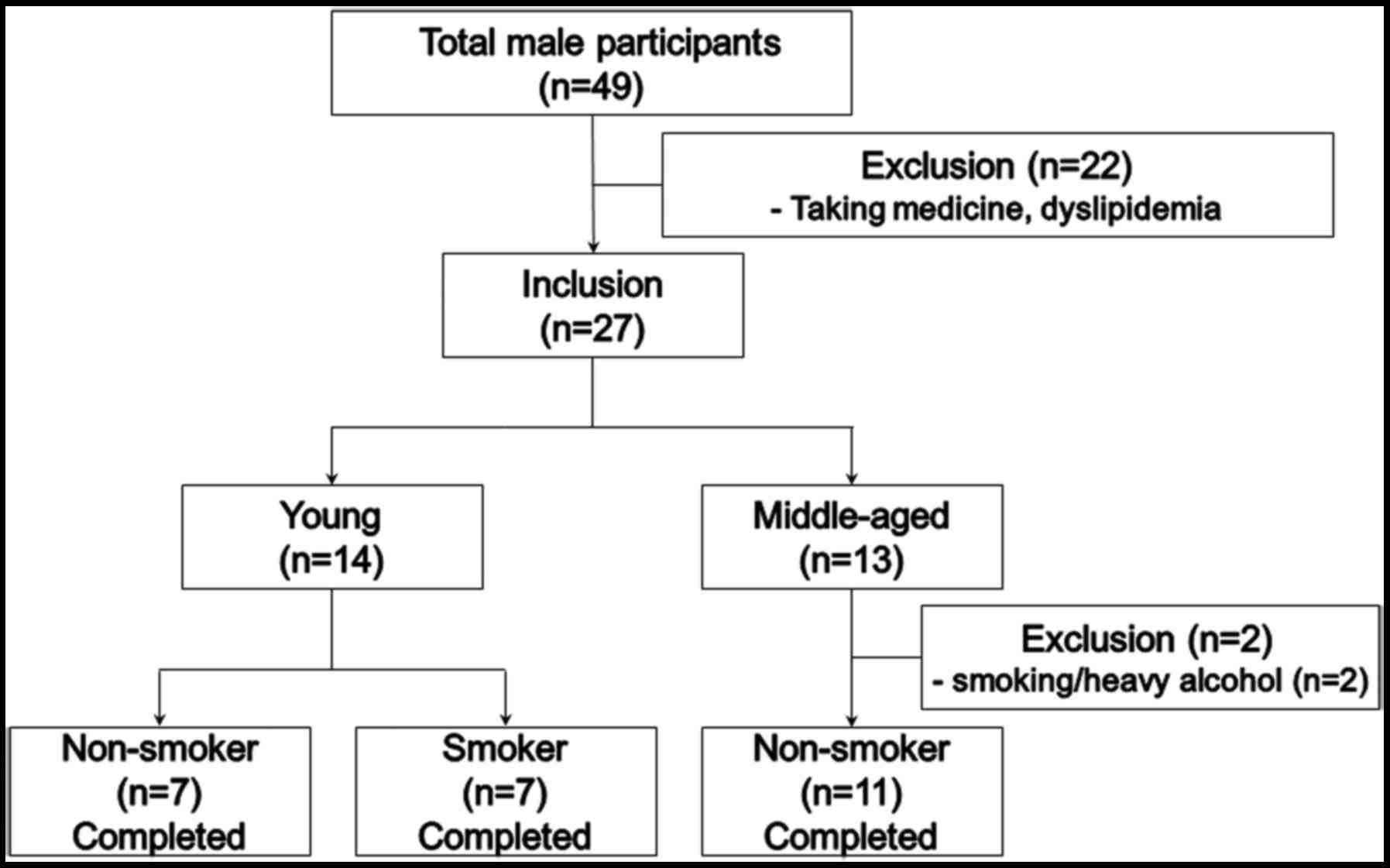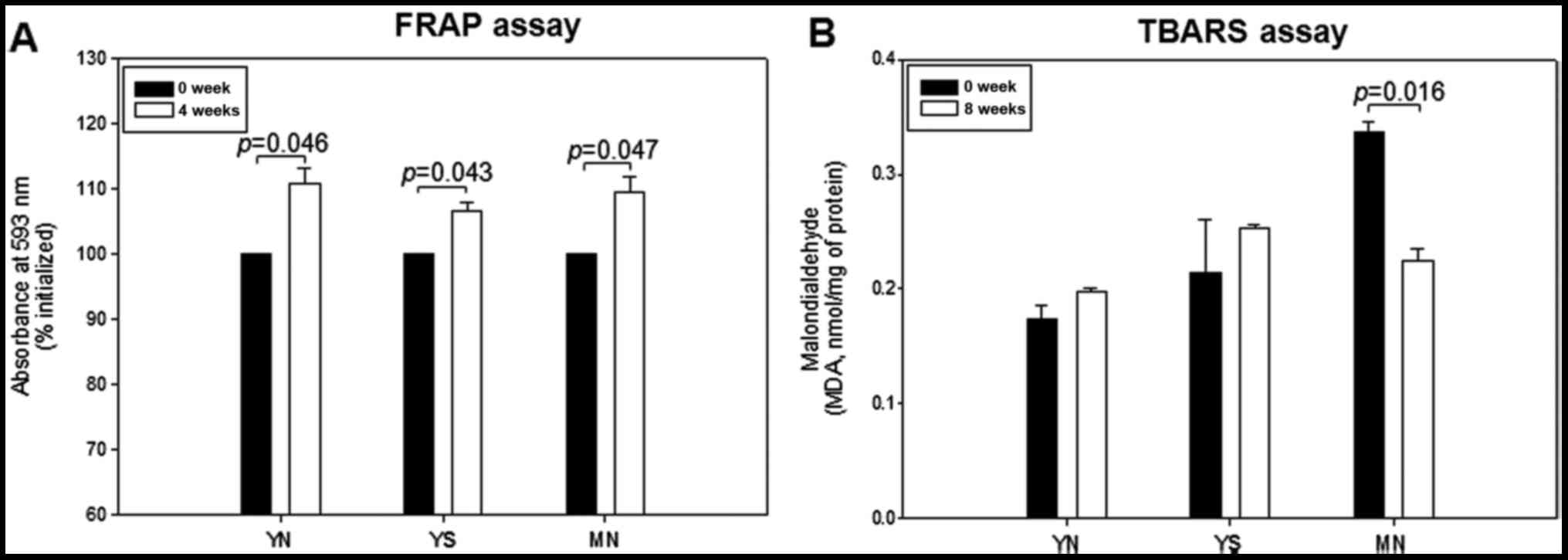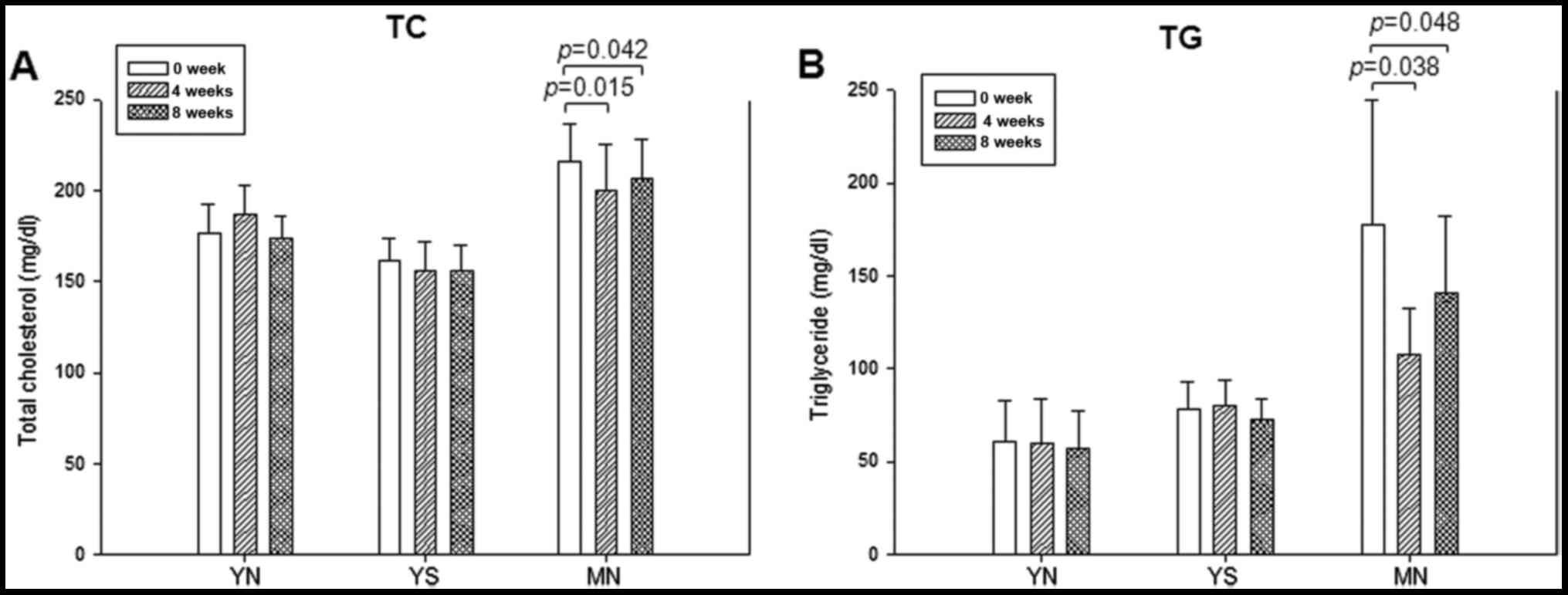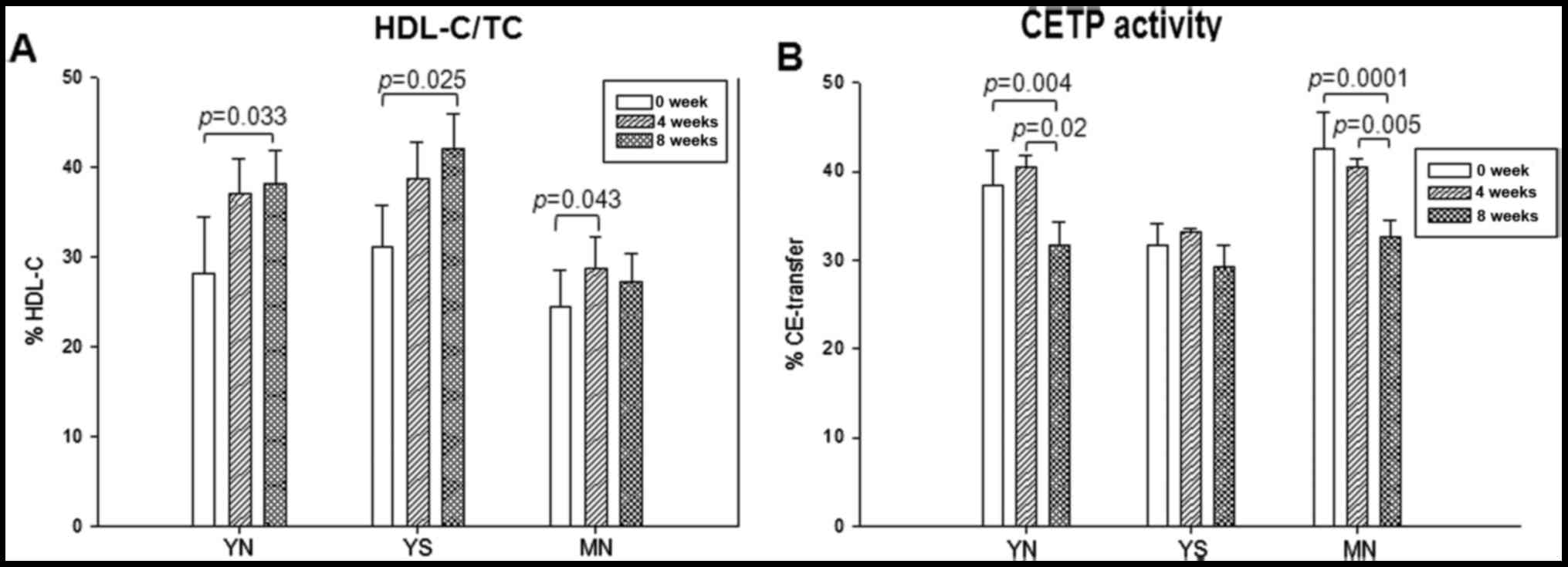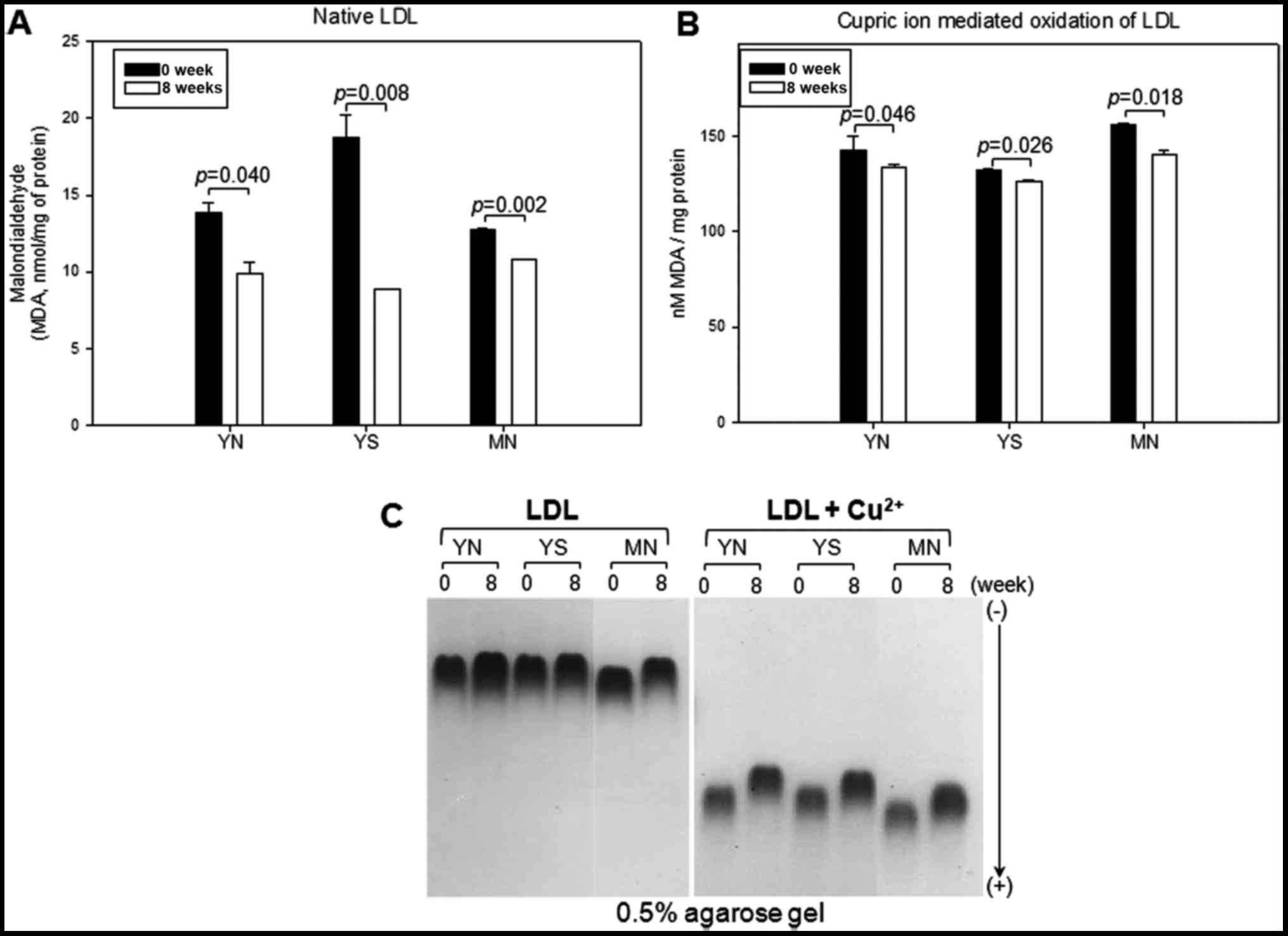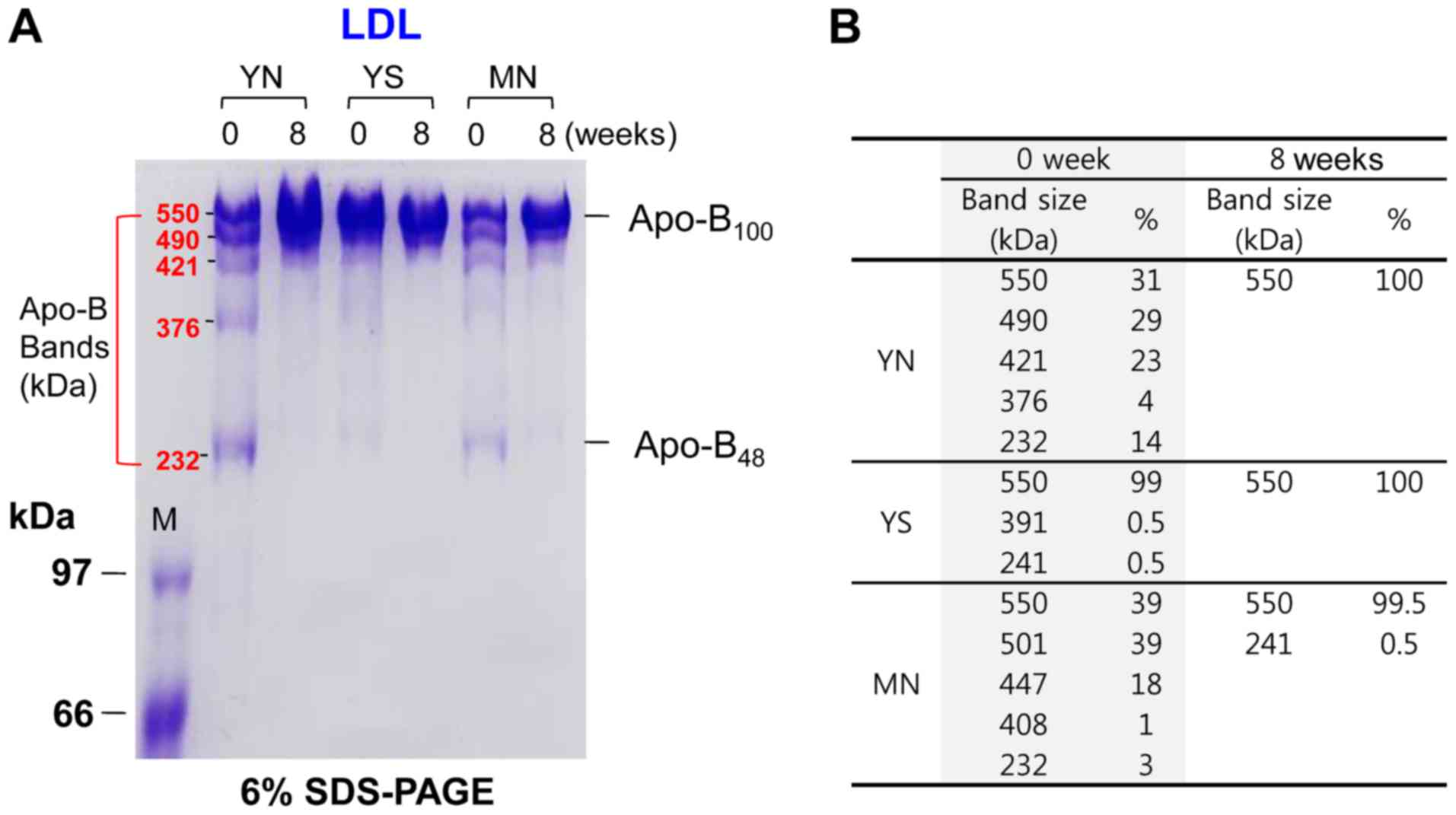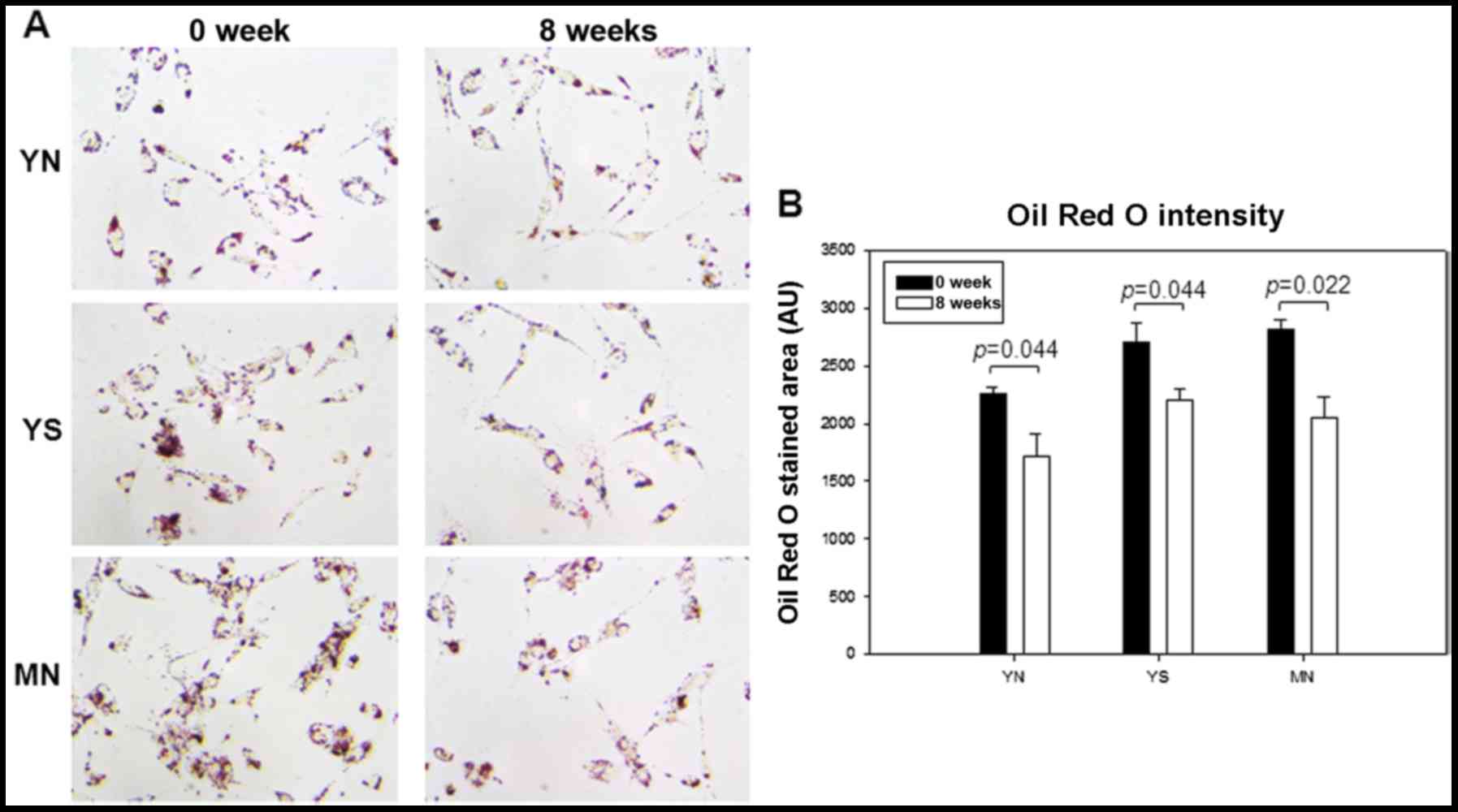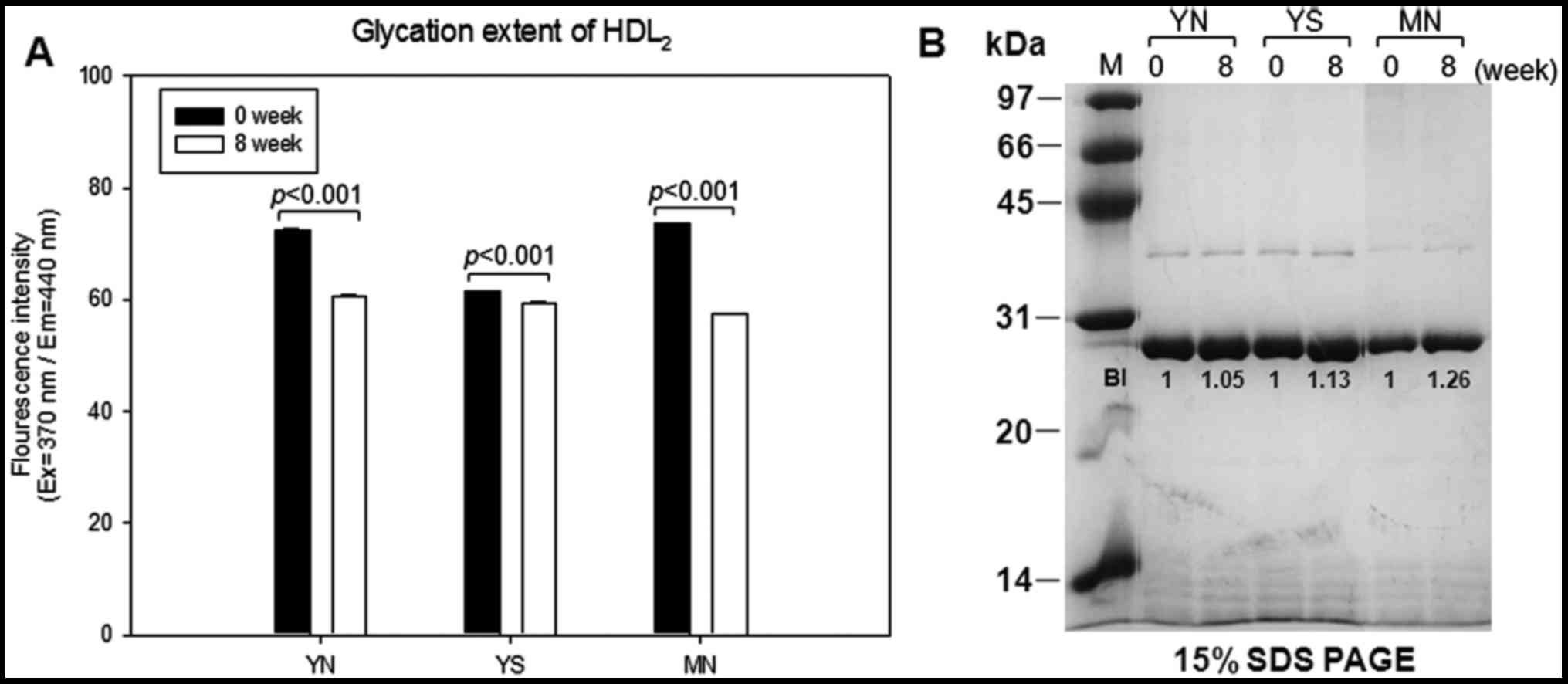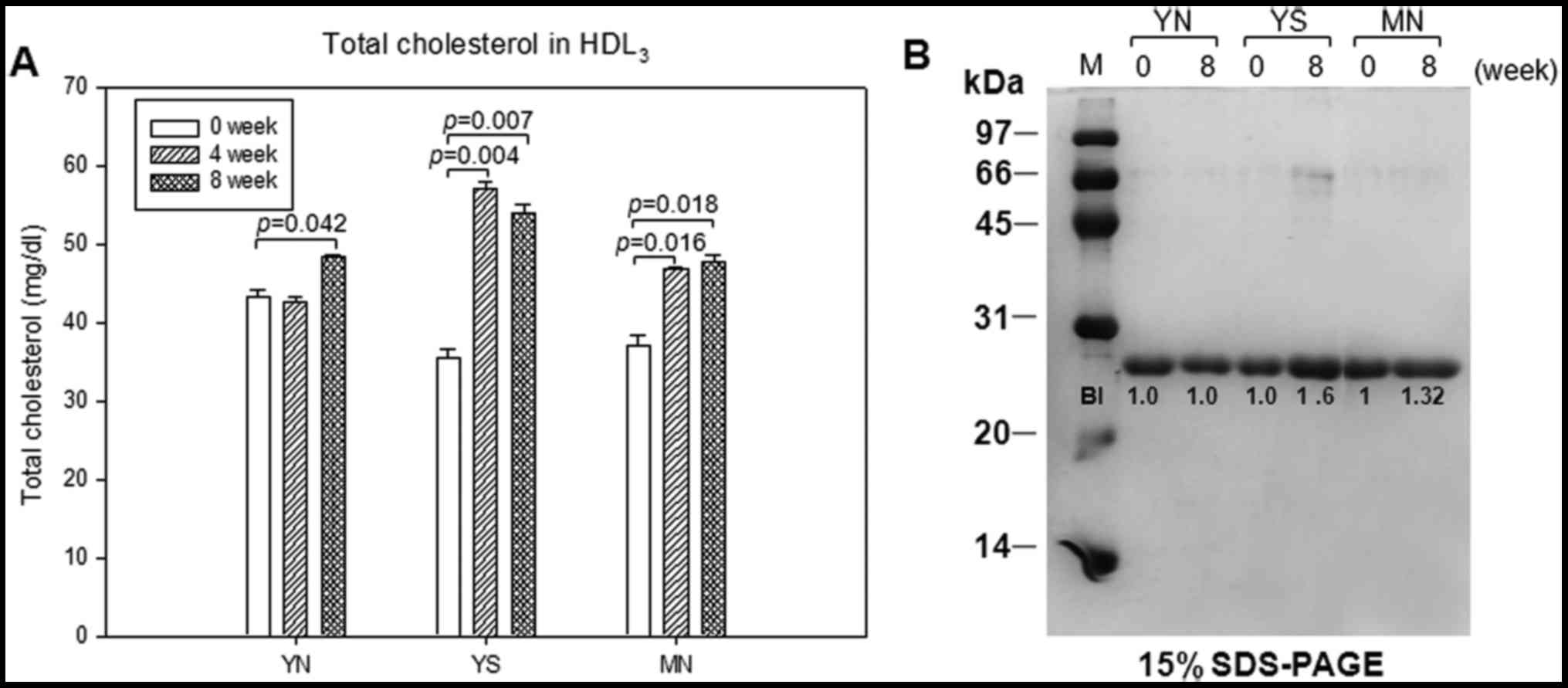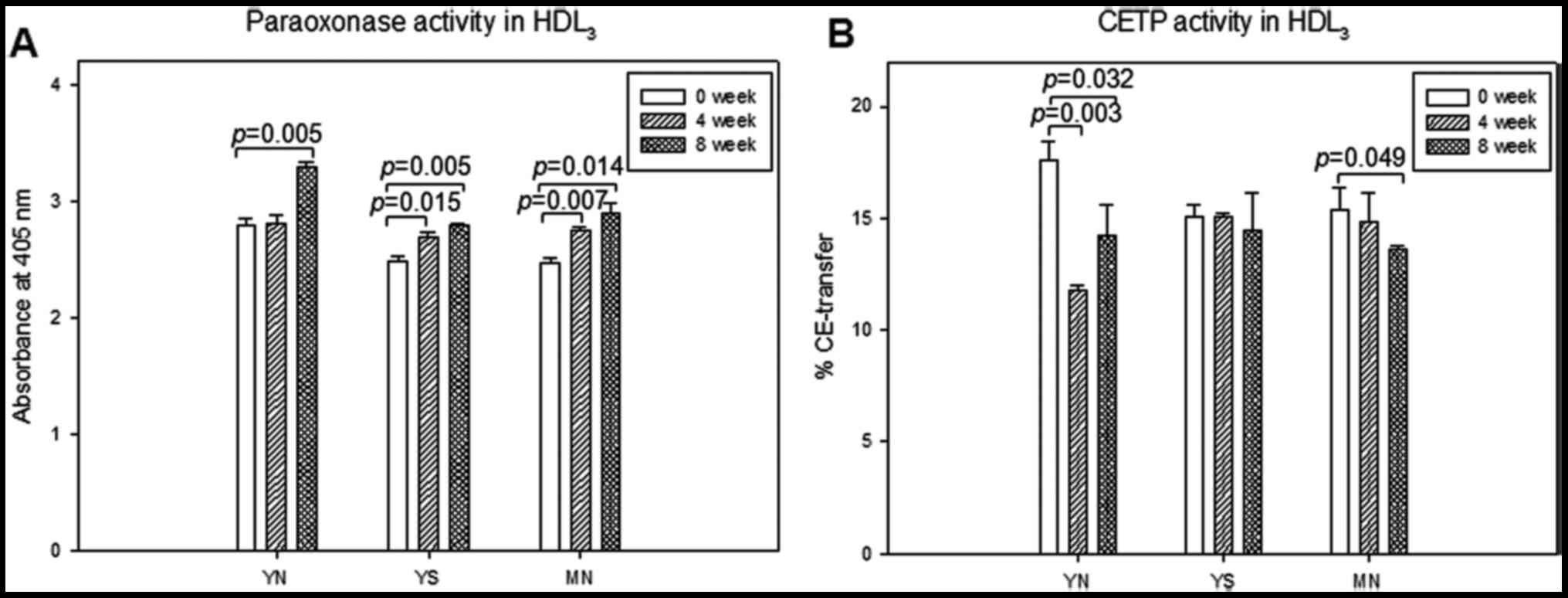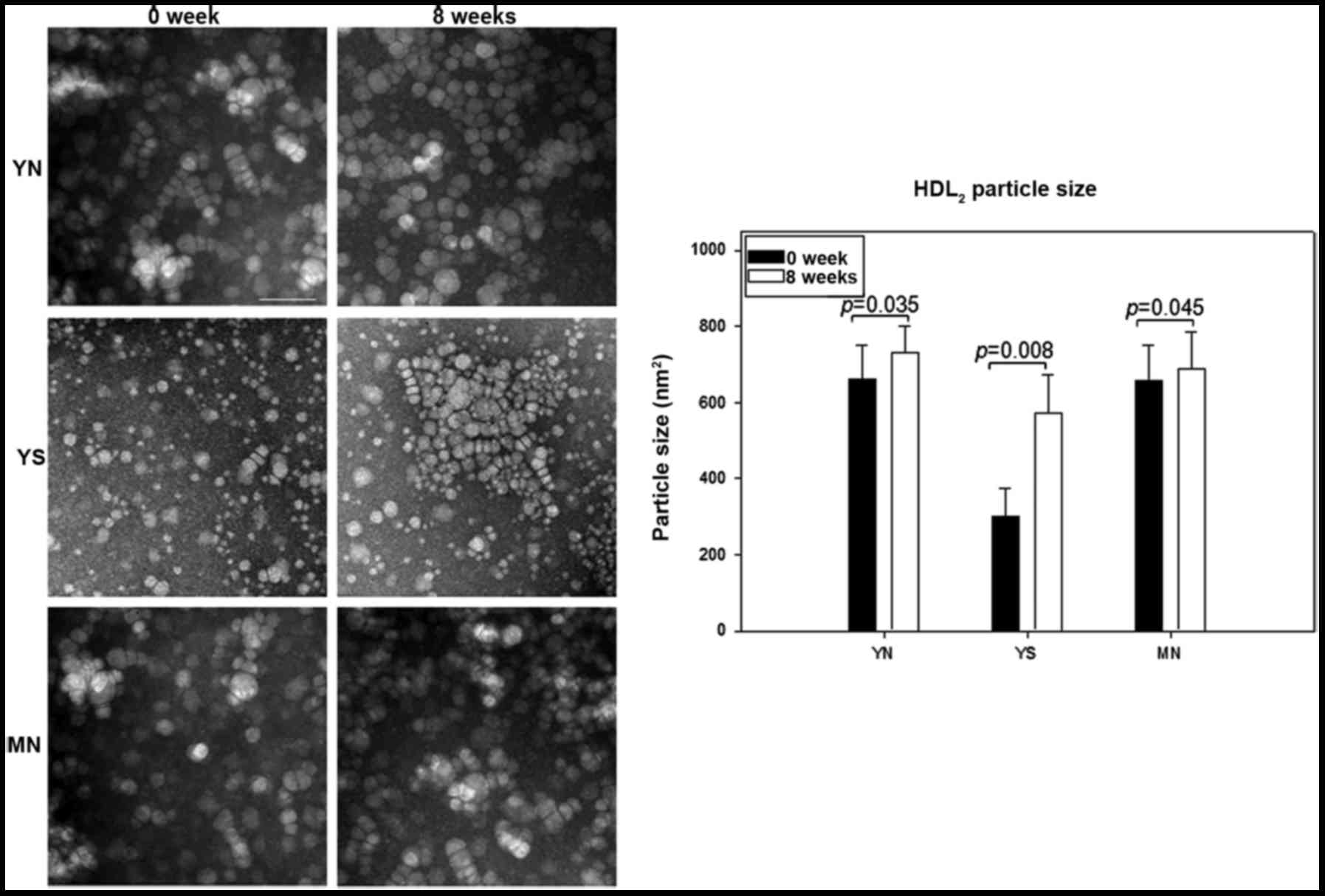|
1
|
Carbajal D, Arruzazabala ML, Valdés S and
Más R: Effect of policosanol on platelet aggregation and serum
levels of arachidonic acid metabolites in healthy volunteers.
Prostaglandins. Leukot Essent Fatty Acids. 58:61–64. 1998.
View Article : Google Scholar
|
|
2
|
Gouni-Berthold I and Berthold HK:
Policosanol: clinical pharmacology and therapeutic significance of
a new lipid-lowering agent. Am Heart J. 143:356–365. 2002.
View Article : Google Scholar : PubMed/NCBI
|
|
3
|
Oliaro-Bosso S, Calcio Gaudino E, Mantegna
S, Giraudo E, Meda C, Viola F and Cravotto G: Regulation of HMGCoA
reductase activity by policosanol and octacosadienol, a new
synthetic analogue of octacosanol. Lipids. 44:907–916. 2009.
View Article : Google Scholar : PubMed/NCBI
|
|
4
|
Greyling A, De Witt C, Oosthuizen W and
Jerling JC: Effects of a policosanol supplement on serum lipid
concentrations in hypercholesterolaemic and heterozygous familial
hypercholesterolaemic subjects. Br J Nutr. 95:968–975. 2006.
View Article : Google Scholar : PubMed/NCBI
|
|
5
|
Kassis AN and Jones PJ: Lack of
cholesterol-lowering efficacy of Cuban sugar cane policosanols in
hypercholesterolemic persons. Am J Clin Nutr. 84:1003–1008.
2006.PubMed/NCBI
|
|
6
|
Guo YL, Xu RX, Zhu CG, Wu NQ, Cui ZP and
Li JJ: Poli cosanol attenuates statin-induced increases in serum
proprotein convertase subtilisin/kexin type 9 when combined with
atorvastatin. Evid Based Complement Alternat Med. 2014:9260872014.
View Article : Google Scholar
|
|
7
|
Menéndez R, Más R, Amor AM, González RM,
Fernández JC, Rodeiro I, Zayas M and Jiménez S: Effects of
policosanol treatment on the susceptibility of low density
lipoprotein (LDL) isolated from healthy volunteers to oxidative
modification in vitro. Br J Clin Pharmacol. 50:255–262. 2000.
View Article : Google Scholar : PubMed/NCBI
|
|
8
|
Kresanov P, Vasankari T, Ahotupa M,
Kaikkonen J, Hutri-Kähönen N, Juonala M, Kähönen M, Lehtimäki T,
Viikari J and Raitakari OT: Paraoxonase-1 and oxidized lipoprotein
lipids. The cardiovascular risk in young finns study.
Atherosclerosis. 241:502–506. 2015. View Article : Google Scholar : PubMed/NCBI
|
|
9
|
Mani P, Uno K, St John J, Tuzcu EM, Nissen
SE and Nicholls SJ: Relation of high-density lipoprotein
cholesterol: apolipoprotein a-I ratio to progression of coronary
atherosclerosis in statin-treated patients. Am J Cardiol.
114:681–685. 2014. View Article : Google Scholar : PubMed/NCBI
|
|
10
|
Chantepie S, Bochem AE, Chapman MJ,
Hovingh GK and Kontush A: High-density lipoprotein (HDL) particle
subpopulations in heterozygous cholesteryl ester transfer protein
(CETP) deficiency: maintenance of antioxidative activity. PLoS One.
7:e493362012. View Article : Google Scholar : PubMed/NCBI
|
|
11
|
Lim SM, Yoo JA, Lee EY and Cho KH:
Enhancement of high-density lipoprotein cholesterol functions by
encapsulation of policosanol exerts anti-senescence and tissue
regeneration effects via improvement of anti-glycation,
anti-apoptosis, and cholesteryl ester transfer inhibition.
Rejuvenation Res. 19:59–70. 2016. View Article : Google Scholar
|
|
12
|
Lee EY, Yoo JA, Lim SM and Cho KH:
Anti-aging and tissue regeneration ability of policosanol along
with lipid-lowering effect in hyperlipidemic zebrafish via
enhancement of high-density lipoprotein functionality. Rejuvenation
Res. 19:149–158. 2016. View Article : Google Scholar :
|
|
13
|
Benzie IF and Strain JJ: The ferric
reducing ability of plasma (FRAP) as a measure of 'antioxidant
power': the FRAP assay. Anal Biochem. 239:70–76. 1996. View Article : Google Scholar : PubMed/NCBI
|
|
14
|
Park KH, Kim JR, Lee JS, Lee H and Cho KH:
Ethanol or water extract of purple sweet potato exhibits
anti-atherosclerotic activity and inhibitory activity against
protein glycation. J Med Food. 13:91–98. 2010. View Article : Google Scholar : PubMed/NCBI
|
|
15
|
Havel RJ, Eder HA and Bragdon JH: The
distribution and chemical composition of ultracentrifugally
separated lipoproteins in human serum. J Clin Invest. 34:1345–1353.
1955. View Article : Google Scholar : PubMed/NCBI
|
|
16
|
Markwell MA, Haas SM, Bieber LL and
Tolbert NE: A modification of the Lowry procedure to simplify
protein determination in membrane and lipoprotein samples. Anal
Biochem. 87:206–210. 1978. View Article : Google Scholar : PubMed/NCBI
|
|
17
|
Blois MS: Antioxidant determinations by
the use of a stable free radical. Nature. 181:1199–1200. 1958.
View Article : Google Scholar
|
|
18
|
McPherson JD, Shilton BH and Walton DJ:
Role of fructose in glycation and cross-linking of proteins.
Biochemistry. 27:1901–1907. 1988. View Article : Google Scholar : PubMed/NCBI
|
|
19
|
Cho KH: Synthesis of reconstituted
high-density lipoprotein (rHDL) containing apoA-I and apoC-III: the
functional role of apoC-III in rHDL. Mol Cells. 27:291–297. 2009.
View Article : Google Scholar : PubMed/NCBI
|
|
20
|
Cho KH, Shin DG, Baek SH and Kim JR:
Myocardial infarction patients showed altered lipoprotein
properties and functions when compared with stable angina pectoris
patients. Exp Mol Med. 41:67–76. 2009. View Article : Google Scholar : PubMed/NCBI
|
|
21
|
Eckerson HW, Wyte CM and La Du BN: The
human serum paraoxonase/arylesterase polymorphism. Am J Hum Genet.
35:1126–1138. 1983.PubMed/NCBI
|
|
22
|
Park KH, Shin DG, Kim JR, Hong JH and Cho
KH: The functional and compositional properties of lipoproteins are
altered in patients with metabolic syndrome with increased
cholesteryl ester transfer protein activity. Int J Mol Med.
25:129–136. 2010.
|
|
23
|
Park KH, Kim JY, Choi I, Kim JR and Cho
KH: ω-6 (18:2) and ω-3 (18:3) fatty acids in reconstituted
high-density lipoproteins show different functionality of
anti-atherosclerotic properties and embryo toxicity. J Nutr
Biochem. 26:1613–1621. 2015. View Article : Google Scholar : PubMed/NCBI
|
|
24
|
Cho KH, Park SH, Park JE, Kim YO, Choi I,
Kim JJ and Kim JR: The function, composition, and particle size of
high-density lipoprotein were severely impaired in an oliguric
phase of hemorrhagic fever with renal syndrome. Clin Biochem.
41:56–64. 2008. View Article : Google Scholar
|
|
25
|
Dulin MF, Hatcher LF, Sasser HC and
Barringer TA: Policosanol is ineffective in the treatment of
hypercholesterolemia: a randomized controlled trial. Am J Clin
Nutr. 84:1543–1548. 2006.PubMed/NCBI
|
|
26
|
Berthold HK, Unverdorben S, Degenhardt R,
Bulitta M and Gouni-Berthold I: Effect of policosanol on lipid
levels among patients with hypercholesterolemia or combined
hyperlipidemia: a randomized controlled trial. JAMA. 295:2262–2269.
2006. View Article : Google Scholar : PubMed/NCBI
|
|
27
|
Castaño G, Más R, Fernández JC, Illnait J,
Fernández L and Alvarez E: Effects of policosanol in older patients
with type II hypercholesterolemia and high coronary risk. J
Gerontol A Biol Sci Med Sci. 56:M186–M192. 2001. View Article : Google Scholar : PubMed/NCBI
|
|
28
|
Minami J, Ishimitsu T and Matsuoka H:
Effects of smoking cessation on blood pressure and heart rate
variability in habitual smokers. Hypertension. 33:586–590. 1999.
View Article : Google Scholar : PubMed/NCBI
|
|
29
|
Kim JH, Shim KW, Yoon YS, Lee SY, Kim SS
and Oh SW: Cigarette smoking increases abdominal and visceral
obesity but not overall fatness: an observational study. PLoS One.
7:e458152012. View Article : Google Scholar : PubMed/NCBI
|
|
30
|
Feig DI: Serum uric acid and the risk of
hypertension and chronic kidney disease. Curr Opin Rheumatol.
26:176–185. 2014. View Article : Google Scholar : PubMed/NCBI
|
|
31
|
Lima WG, Martins-Santos ME and Chaves VE:
Uric acid as a modulator of glucose and lipid metabolism.
Biochimie. 116:17–23. 2015. View Article : Google Scholar : PubMed/NCBI
|
|
32
|
Park KH, Shin DG, Kim JR and Cho KH:
Senescence-related truncation and multimerization of apolipoprotein
A-I in high-density lipoprotein with an elevated level of advanced
glycated end products and cholesteryl ester transfer activity. J
Gerontol A Biol Sci Med Sci. 65:600–610. 2015.
|
|
33
|
Michel CC, Nanjee MN, Olszewski WL and
Miller NE: LDL and HDL transfer rates across peripheral
microvascular endothelium agree with those predicted for passive
ultrafiltration in humans. J Lipid Res. 56:122–128. 2015.
View Article : Google Scholar :
|
|
34
|
Marsche G, Holzer M and Wolf P:
Antipsoriatic treatment extends beyond the skin: recovering of
high-density lipoprotein function. Exp Dermatol. 23:701–704. 2014.
View Article : Google Scholar : PubMed/NCBI
|
|
35
|
Fujioka Y and Ishikawa Y: Remnant
lipoproteins as strong key particles to atherogenesis. J
Atheroscler Thromb. 16:145–154. 2009. View Article : Google Scholar : PubMed/NCBI
|
|
36
|
Barzilai N, Atzmon G, Schechter C,
Schaefer EJ, Cupples AL, Lipton R, Cheng S and Shuldiner AR: Unique
lipoprotein phenotype and genotype associated with exceptional
longevity. JAMA. 290:2030–2040. 2003. View Article : Google Scholar : PubMed/NCBI
|
|
37
|
Kim SM, Lim SM, Yoo JA, Woo MJ and Cho KH:
Consumption of high-dose vitamin C (1250 mg per day) enhances
functional and structural properties of serum lipoprotein to
improve anti-oxidant, anti-atherosclerotic, and anti-aging effects
via regulation of anti-inflammatory microRNA. Food Funct.
6:3604–3612. 2015. View Article : Google Scholar : PubMed/NCBI
|
|
38
|
Gotto AM Jr and Moon JE: Pharmacotherapies
for lipid modification: beyond the statins. Nat Rev Cardiol.
10:560–570. 2013. View Article : Google Scholar : PubMed/NCBI
|
|
39
|
Haas MJ, Onstead-Haas LM, Szafran-Swietlik
A, Kojanian H, Davis T, Armstrong P, Wong NC and Mooradian AD:
Induction of hepatic apolipoprotein A-I gene expression by the
isoflavones quercetin and isoquercetrin. Life Sci. 110:8–14. 2014.
View Article : Google Scholar : PubMed/NCBI
|
|
40
|
Egert S, Bosy-Westphal A, Seiberl J,
Kürbitz C, Settler U, Plachta-Danielzik S, Wagner AE, Frank J,
Schrezenmeir J, Rimbach G, et al: Quercetin reduces systolic blood
pressure and plasma oxidised low-density lipoprotein concentrations
in overweight subjects with a high-cardiovascular disease risk
phenotype: a double-blinded, placebo-controlled cross-over study.
Br J Nutr. 102:1065–1074. 2009. View Article : Google Scholar : PubMed/NCBI
|
|
41
|
Nazratun N, Mahmood AA, Kuppusamy UR,
Ahmad TS and Tan SY: Diabetes mellitus exacerbates advanced
glycation end product accumulation in the veins of end-stage renal
failure patients. Vasc Med. 11:245–250. 2006. View Article : Google Scholar
|
|
42
|
Semba RD, Sun K, Schwartz AV, Varadhan R,
Harris TB, Satterfield S, Garcia M, Ferrucci L and Newman AB: Serum
carboxymethyl-lysine, an advanced glycation end product, is
associated with arterial stiffness in older adults. J Hypertens.
33:797–803. 2015. View Article : Google Scholar : PubMed/NCBI
|
|
43
|
Phillips CM and Perry IJ: Lipoprotein
particle subclass profiles among metabolically healthy and
unhealthy obese and non-obese adults: does size matter?
Atherosclerosis. 242:399–406. 2015. View Article : Google Scholar : PubMed/NCBI
|
|
44
|
Kontush A and Chapman MJ: Why is HDL
functionally deficient in type 2 diabetes? Curr Diab Rep. 8:51–59.
2008. View Article : Google Scholar : PubMed/NCBI
|
|
45
|
Kastelein JJ, Besseling J, Shah S,
Bergeron J, Langslet G, Hovingh GK, Al-Saady N, Koeijvoets M,
Hunter J, Johnson-Levonas AO, et al: Anacetrapib as lipid-modifying
therapy in patients with heterozygous familial
hypercholesterolaemia (REALIZE): a randomised, double-blind,
placebo-controlled, phase 3 study. Lancet. 385:2153–2161. 2015.
View Article : Google Scholar : PubMed/NCBI
|















